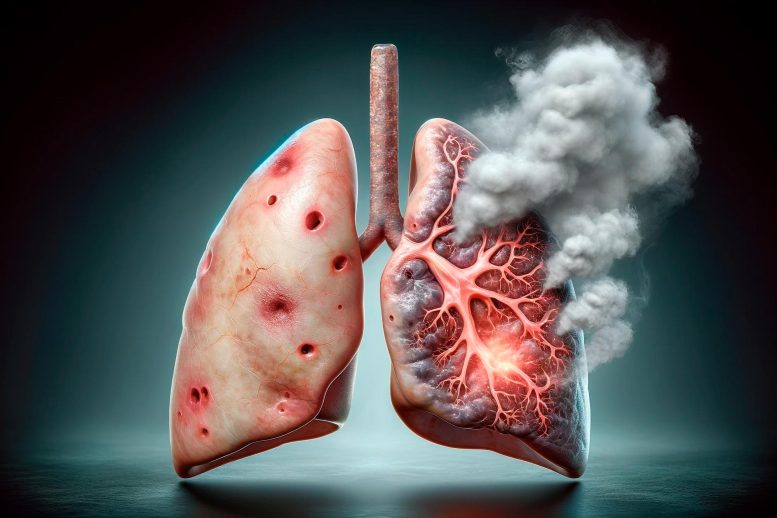
Research from Concordia University has revealed how vaping additives, particularly tocopherol (vitamin E), can harm lung function, contributing to a condition known as EVALI. The study used advanced techniques to demonstrate how these substances interfere with the lung’s surfactant, essential for breathing. This is particularly concerning for young people, who are more likely to vape, emphasizing the need for informed decisions regarding health and regulatory oversight. Credit: SciTechDaily.com
Vitamin E binds itself to the pulmonary surfactant, inhibiting gas exchange and lung stability.
The health risks associated with consumption of tobacco and cannabis products are well-established by now. Much less understood are the risks associated with vaping, particularly flavored products popular with young adults.
It is an increasingly pressing issue: Statistics Canada says one in 10 Canadians aged 20 to 24 and one in 15 aged 15 to 19 reported to have vaped every day in 2022.
Writing in the journal Langmuir, Concordia researchers show how the e-cigarette additive tocopherol — an organic compound better known as vitamin E — and tocopherol acetate can damage the lungs. The study adds to the growing body of literature on what has become known as electronic cigarette or vaping product use–associated lung injury (EVALI).
When heated and inhaled, the compound embeds in the pulmonary surfactant, a nanoscopically thin lipid protein membrane coating the surface of the alveoli that regulates the oxygen-carbon dioxide gas exchange and stabilizes the lungs’ surface tension during breathing.
Molecular-Level Models
The study was helmed by Christine DeWolf, a professor in the Department of Chemistry and Biochemistry and co-founder of the Centre for NanoScience Research. The researchers used one-molecule-thick model membranes called Langmuir films to simulate the expansion and compression of the pulmonary surfactant. They then added vitamin E, which is structurally similar to the lipids found in the membrane.
They used different observational techniques including microscopy, x-ray diffraction and x-ray reflectivity. The researchers observed how the presence of the additive changed the surfactant’s properties and monitored changes as they added more — just as a real surfactant would accumulate and retain the compound in the lungs.
“We can see that the presence of vitamin E changes the functional properties of the surfactant,” DeWolf explains.
“Oxygen is exchanged for carbon dioxide across the pulmonary surfactant, so if the surfactant properties are altered, so can be the ability for gas to be exchanged. And if the surface tension is changed, that affects the work of breathing. So combined, these changes make breathing more difficult. We think this is the molecular basis contributing to the shortness of breath and reduced oxygen levels seen in people suffering from EVALI.”
Youth at Particular Risk
This paper is the first of a larger project that looks at the components of the vaping solutions that deliver the nicotine or cannabinoids to users.
“Many of the components in these solutions are approved by the United States Food and Drug Administration for other uses,” DeWolf says. “But the high heating rates needed to vaporize these components can cause further chemical reactions to occur. The components that are actually being inhaled may not be the ones in the original e-liquid.”
MSc student Panagiota Taktikakis is the paper’s lead author. “Understanding the impact of vaping additives on lung surfactant is vital, particularly for younger generations who are more influenced by vaping trends,” she adds.
“This research reveals critical insights into the potential short- and long-term consequences of vaping, empowering young individuals to make informed choices about their health and well-being.”
The researchers say they hope their work can be used to educate regulatory bodies about risks posed by certain carrying agents and whether the additives they contain can inhibit lung function.
Reference: “Understanding the Retention of Vaping Additives in the Lungs: Model Lung Surfactant Membrane Perturbation by Vitamin E and Vitamin E Acetate” by Panagiota Taktikakis, Mathieu Côté, Nivetha Subramaniam, Kailen Kroeger, Hala Youssef, Antonella Badia and Christine DeWolf, 4 March 2024, Langmuir.
DOI: 10.1021/acs.langmuir.3c02952
Mathieu Côté, Nivetha Subramaniam, Kailen Kroeger, Hala Youssef and Antonella Badia contributed to this paper.
The study was supported by the Natural Sciences and Engineering Research Council of Canada (NSERC).










Putting anything in your lungs except air is BAD!